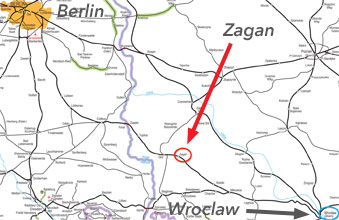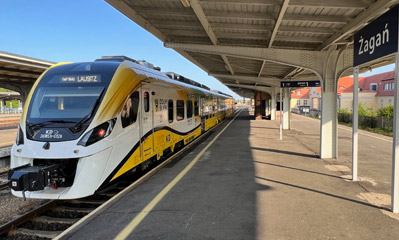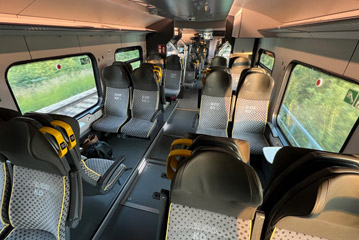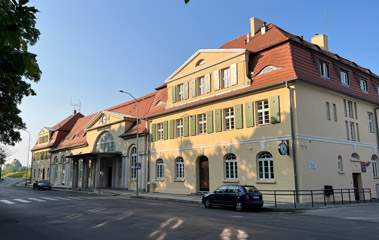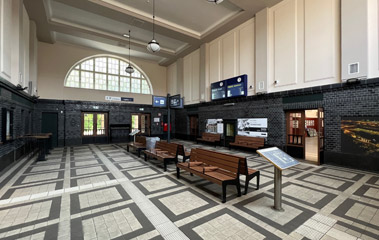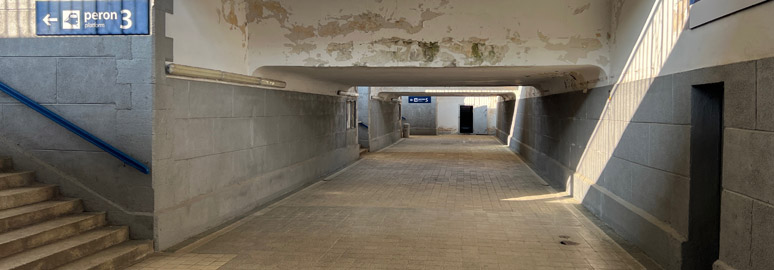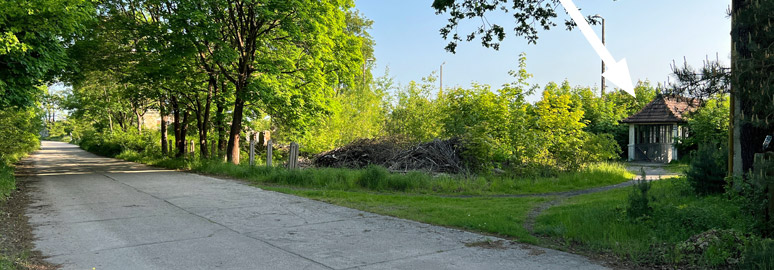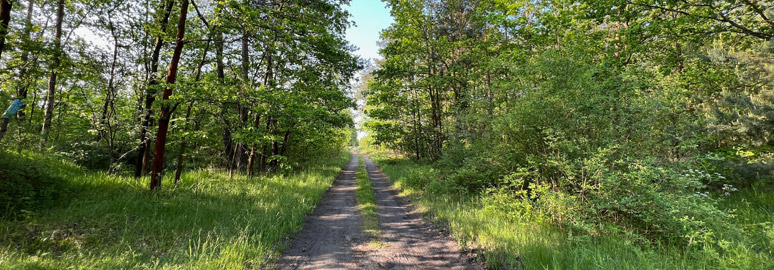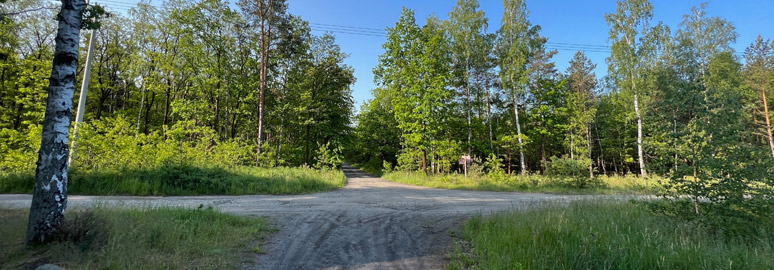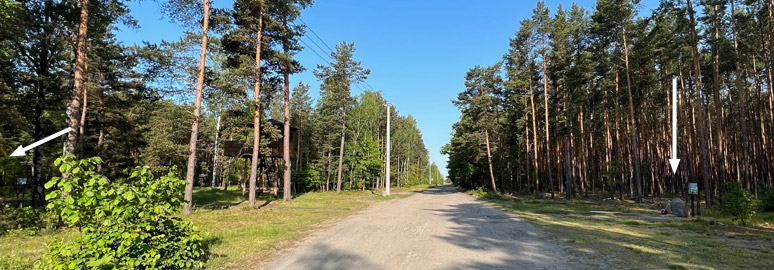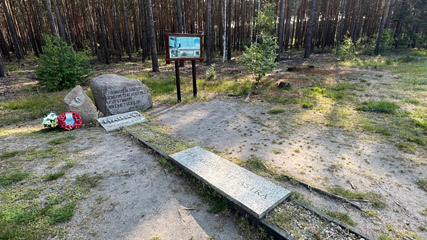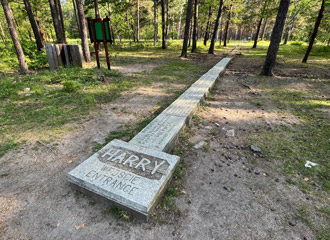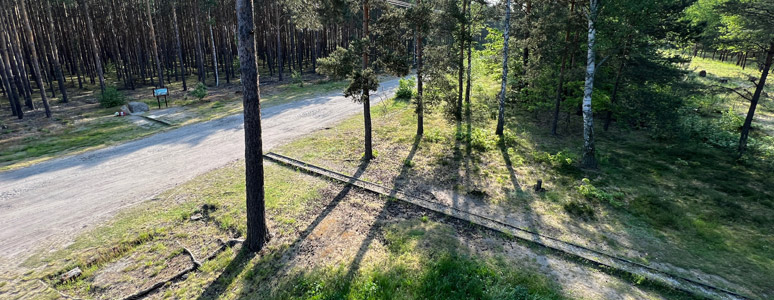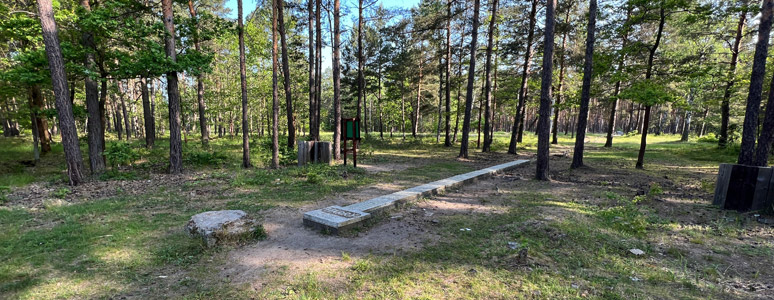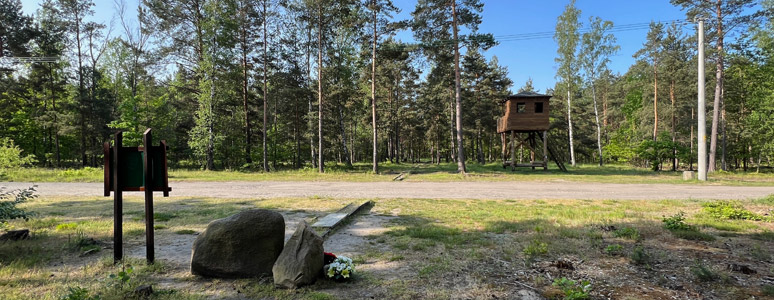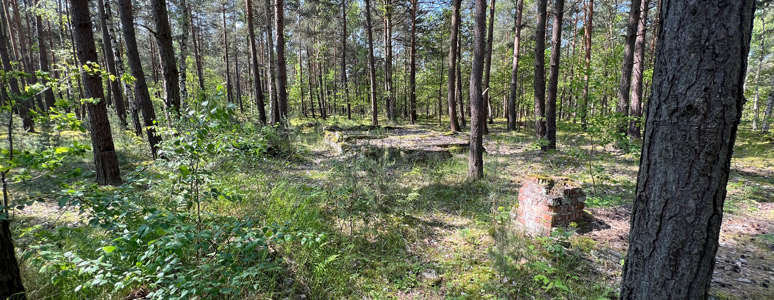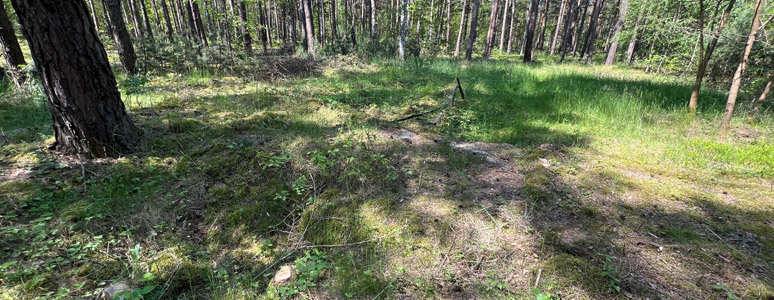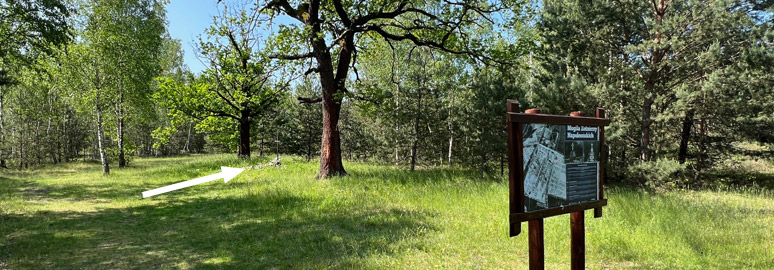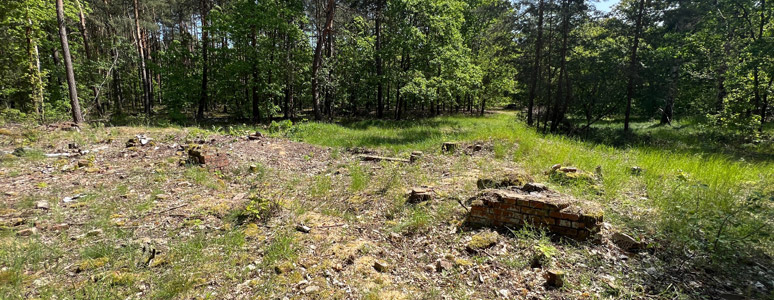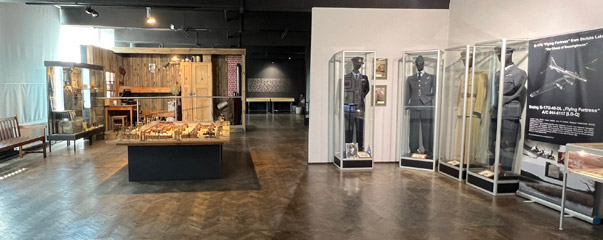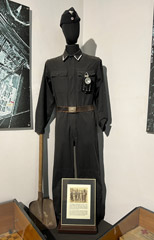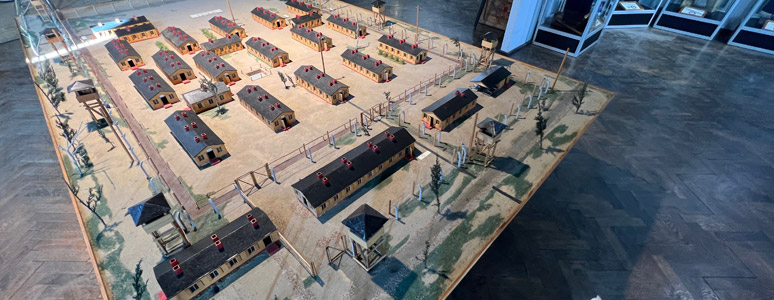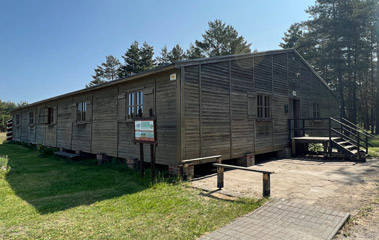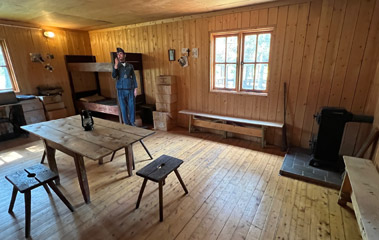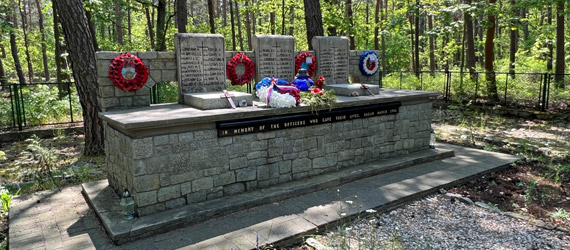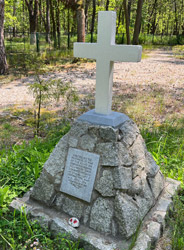A day trip from Wroclaw or Berlin...
Almost every Christmas, the 1963 film The Great Escape hits our screens complete with Steve McQueen on a motorcycle. You may also have seen the 1950 film, The Wooden Horse. Both are based on real escapes from the same World War 2 prisoner of war (PoW) camp, Stalag Luft 3 at Zagan in what is now Poland. The PoW huts and barbed wire are gone and the area is now covered in forest, but it's freely accessible to the public and only 10 minutes walk from Zagan station. With the excellent Stalag Luft 3 Museum also walking distance from the station, Zagan makes a truly thought-provoking day out from Wroclaw or a long but easily achievable day trip from Berlin or Dresden. This page tells you how.
Getting to Zagan by train...
Wroclaw to Zagan
It's 140 km (87 miles) from Wroclaw to Zagan, the journey takes 2 hours with a change of train at Legnica using regional trains run by local operator KD. There are one or two daily direct trains (including a direct Intercity train from Krakow & Wroclaw to Zagan run by PKP Intercity) but these are not timed for day trips. For a day trip I'd stick to the KD regional trains.
To find train times from Wroclaw to Zagan, use the KD website kolejedolnoslaskie.pl. It's in Polish but easy enough to work out, simply use Google's Chrome browser, right click and click Translate to English. You can click Kup bilet and buy online (you print your own ticket) or simply buy at Wroclaw Glowny ticket office on the day, it's easy - look for the ticket window marked as selling KD regional tickets.
The fare is around 35 zlotys (€8) each way, a bargain. Tickets have unlimited availability, you can buy them on the day of travel if you like, they cannot sell out. As the journey is over 100 km, the ticket is good for any departure that day. You sit where you like.
Tip: kolejedolnoslaskie.pl won't suggest impossible connections, but trains to Zagan are infrequent so you don't want to miss a connection because of a few minutes' delay. So for the outward journey I recommend clicking Wyszukiwanie szczegółowe (= advanced search) then changing co najmniej 5 minut (= connection at least 5 minutes) to co najmniej 20 minut (= connection at least 20 minutes). On the way back it doesn't matter, there are lots of trains from Legnica to Wroclaw if you were to miss one.
For example, at the time I write this a train leaves Wroclaw at 07:47 on Mondays-Fridays with a robust 36 minute change of train in Legnica, arriving Zagan at 10:24. You could leave at 08:30 if you risked a 5 minute connection in Legnica, but I'd play safe and take the earlier train. Service varies by day of the week so see what's available on your date of travel using kolejedolnoslaskie.pl.
I'd want at least 4 hours at Zagan, so for the way back (again, just an example as it varies) there's a 14:40 train from Zagan, change at Legnica, arriving Wroclaw 17:33, or a 17:03 train from Zagan, change Legnica, arriving Wroclaw at 19:09.
Below, a comfortable air-conditioned KD regional train of the sort used between Wroclaw, Legnica, Zagan & Forst (Lausitz). 2nd class only with toilets & power sockets. Larger photo.
Berlin to Zagan
It's 280 km (174 miles) from Berlin to Zagan via Cottbus & Forst. A double-deck regional express train runs from Berlin Hbf to Cottbus every hour, connecting with another regional train to Zagan which runs every 3 hours or so Mondays-Fridays. Trains also run at weekends, but an extra change at Forst is necessary.
You can check times and buy tickets from Berlin to Zagan at the German Railways website int.bahn.de.
At the time I write this you can leave Berlin Hbf at 07:23 on Mondays-Fridays, change at Cottbus, arriving Zagan at 10:15.
This involves a slick 9-minute connection in Cottbus which should work fine, but if there's a delay you'll have 3 hours to wait till the next train so I would play safe and take the previous 06:23 train from Berlin to Cottbus and have a coffee at Cottbus station.
On the way back, there's a train leaving Zagan at 16:40 Mondays-Fridays, change at Cottbus, arriving Berlin Hbf 19:35.
You cannot buy the ticket at Bahn.de as it's a VBB (Berlin transit authority) regional fare, buy it at the station on the day, no reservation needed, it cannot sell out.
Berlin to Zagan costs around €22.50 each way at the VBB regional tariff. See www.vbb.de/en/vbb-travel-info.
The photo below shows a double-deck regional train from Berlin to Cottbus, at Cottbus station.
Dresden to Zagan
You can also visit Stalag Luft 3 as a day trip from Dresden. To find times, use the German Railways website int.bahn.de. At the time I write this a regional express train leaves Dresden at 07:29 on Mondays-Saturdays, change at Görlitz, arriving Zagan at 10:43. However, you need to split the booking to buy tickets online: First book from Dresden Hbf to Zgorzelec using int.bahn.de (Zgorzelec is the first stop in Poland made by the train from Görlitz to Zagan). Then book from Zgorzelec to Zagan on the same train at polregio.pl, it's in Polish, but easy enough to work out, use Google Chrome, right click and click Translate to English. You print your own tickets or can show them on your phone. Book the return journey as a second one-way trip in a similar way, first checking times from Zagan to Dresden at int.bahn.de, then splitting the booking either side of Zgorzelec. You may find an extra change is necessary on the way back in the afternoon.
Staying in Zagan overnight
Zagan has limited hotel options, all located in the town a few km north of the station. Try the Willa Park Hotel, Pensjonat Bartosz or Apartament Książęcy.
Arrival at Zagan station
Before 1945, this whole area was part of Germany and Zagan - then spelt Sagan - was an important junction on the busy Berlin-Breslau main line. Today it's part of Poland and the German regional capital Breslau is now the Polish city of Wroclaw. These days, Berlin-Wroclaw trains take a more northerly route via Rzepin & Zielena Gora, and Zagan's vast array of empty platforms are served by a motley handful of infrequent regional trains. There's no left luggage and no ticket office, just a solitary ticket machine in the impressive main hall. A room off the main hall houses a small railway museum which is well worth a look if it's open.
Zagan station. The small railway museum is through the open door visible in the station entrance hall. The wooden horse escapers crossed the line on a footbridge to the east of the station and would have entered the booking hall through the main entrance. One of them queued up for tickets at the ticket windows visible on the left (the ticket office is now closed). Larger photo.
Stalag Luft 3 or III?
Zagan has been a military town since the 18th century, and it's still a training base for the Polish army today. In WW2, the Wehrmacht (German army) built Stalag VIIIC for army prisoners here, 'C' denoting the third PoW camp in military district VIII, based in Breslau. The Luftwaffe decided to build a large camp for air force prisoners here too, Stalag Luft 3, the '3' indicating the third Luftwaffe-run PoW camp for air force prisoners in Germany. Stalag Luft 3 grew steadily over the years, the original east compound where the wooden horse escape took place was soon followed by central, north, south & west compounds. The Great Escape was from the north compound.
The Germans always wrote it as Stalag Luft 3. Australian prisoner of war Paul Brickhill also wrote it as Stalag Luft 3 when drafting his book, The Great Escape on which the 1963 film is based. However, his editors insisted on changing it to Stalag Luft III, no doubt for consistency with the neighbouring Stalag VIIIC, unaware of the difference in meaning. The camp has since usually been known as Stalag Luft III. Editors, eh?
The Riddle of the Missed Trains
You start learning about the Great Escape even before leaving the station. If you try to check the walking route from Zagan station to Stalag Luft 3 using Google Maps, Google wants to send you a very long way round via the main exit from the station on the northern side, see for yourself. Surely there's a direct exit from the south side of the station? I zoomed in on a Google satellite view trying to find one, and failed. Then with a shiver I read how some of the Great Escapers missed their trains because they couldn't find their way into the station from the south side in the dark. I realised I was having a similar problem to these Great Escapers, but in the opposite direction. On arrival in Zagan I found the south side exit from the station and I'm not surprised they couldn't find it. Read on...
How to walk to Stalag Luft 3
Here's the correct walking route from the station to Tunnel Harry, it's 800m and takes only 10 minutes, a pleasant stroll through a peaceful Polish forest.
1. There is indeed an exit from Zagan station on the south side. Go down the steps from the platform into the pedestrian subway under the tracks and turn left. At the far end you'll see an unmarked grey steel door, wedged open, visible in the photo above. Walk through this doorway, through the former WW2 air raid shelter and up the steps to the road on the south side of the station. Many of the Great Escapers would have entered the station this way.
2. The steps emerge in a small poorly-marked hut, set back from the road and easy to miss even in daylight. I'm not surprised the Great Escapers couldn't find it! In the photo above it's indicated by the arrow. The road is called Towarowa, it runs parallel with the railway platforms.
3. While you're here, look into the undergrowth on the opposite side of the road and you'll see the overgrown curved roof of a WW2 air-raid shelter (in the photo above it's just out of shot to the left). There's another one a little further on. Some of the Great Escapers reached the station during an air raid and were told to take cover in a shelter, it's not known whether they used the one in the entrance to the station or one of these two.
4. After walking a few metres west along Towarowa, take the first left turn along the rural country lane shown in the photo above, heading south. Stalag Luft 3 was run by the Luftwaffe for air force prisoners, most would have been captured after their aircraft was shot down. They'd have travelled to Zagan by train under guard then been marched to the camp along this very lane.
5. A few minutes later you reach the crossroads shown above, at the northern boundary of Stalag Luft 3. Turn right (west) and walk along the camp perimeter.
6. A few hundred meters west of the crossroads you reach the memorial to Tunnel Harry. The photo above shows the view as you arrive at Tunnel Harry, looking west. The road itself and the woods on the right are outside the camp boundary, the Stalag Luft 3 perimeter wire would have been immediately to the left of the road. The arrow on the right marks the exit from Tunnel Harry, just short of the tree-line. The tunnel entrance in hut 104 is much further back to the left, indicated by the other arrow. The tunnel ran out of the prisoner's compound, under a smaller administrative compound and under the road. The guard tower just visible in the trees is a replica which you can climb into, but it's in more or less in the original location.
7. The whole camp area is open and accessible to anyone who cares to walk there, there are no fences, no opening or closing times and no entrance fee.
Tunnel Harry & The Great Escape
You can read about the Great Escape at en.wikipedia.org/wiki/Stalag_Luft_III#Great_escape. Three 9-metre deep tunnels were dug in the north compound, code-named Tom, Dick & Harry. Tom and Dick ran westwards from huts 123 & 122, and Harry northwards from hut 104, under an administrative compound and under the road into the forest on the north side. The Germans started clearing trees to build a new West compound, and it became clear that by the time Tom & Dick were ready they'd lead from one compound into another, so efforts were concentrated on Harry.
However, the Germans got closer and closer to discovering the tunnels and the escape committee faced another setback, the American prisoners who'd been heavily involved with the tunnel were removed to the South compound. It was decided that tunnel Harry would be used for a mass breakout on the night of 24/25 March 1944, for as many as 200 prisoners. This was sooner than they'd have liked for two reasons: It was still winter with persistent snowy conditions, and the tunnel was still dangerously short of the tree line. The 1963 film suggests that the prisoners miscalculated the length of the tunnel, it's more likely that the premature use of the tunnel meant it was shorter than planned. The exit was visible to the nearest guard tower, so an escaper could only leave the tunnel exit every 6 minutes, not every minute as planned. Nevertheless, some 76 PoWs escaped that night before the tunnel exit was spotted and the remaining would-be escapers aborted.
Of the 76 escapers, only 3 were successful (two Norwegian and one Dutch officer). 23 were returned to captivity, and 50 were shot by a direct order from Hitler, contrary to the Geneva Convention. Today, the line of tunnel Harry is marked out with a memorial, inscribed with the names of those who died.
The actual tunnel may not in fact run directly beneath the memorial. Although not conclusive, initial Ground Penetrating Radar results suggest the tunnel may run a metre or two east of the memorial, roughly level with the information board in the photo below left.
Above left, the exit from Tunnel Harry. Above right, the entrance. The four corners of hut 104 are marked out with wooden posts, you can see one of these in the photo above right, to the left of the information board. Click the images for larger photos.
You can climb the replica guard tower. Above, this is the view from the tower, looking towards the exit from Harry on the far side of the road.
Above, a wide view of the entrance to Harry, hidden under a heating stove in hut 104. I am told that the concrete block to the left of the memorial is the original block that sealed the entrance to the tunnel (I was told some time after sitting on it to eat my sandwich).
Looking back from the entrance towards hut 104. The length of the tunnel is quite remarkable.
Tunnels Tom & Dick
In contrast to tunnel Harry, Tom and Dick are currently unmarked and much more difficult to find. I have marked their approximate position on this map.
Above, the remains of hut 123, looking roughly from the entrance door along the central corridor, with the solid foundations of the toilets & washrooms visible to the right of the corridor. Tunnel Tom ran westwards from beneath a drain in those washroom foundations. After the Great Escape in March 1944, the Germans discovered Tom and used explosives to destroy it. The explosives damaged the washroom foundations, which had to be repaired. You can still see the damage caused by that explosion today.
Above, tunnel Dick ran westwards from hut 122. Until recently its course was marked by some steel railings, just visible here but now broken and twisted. Tunnel Dick also ran from a drain in a washroom, it was eventually used as a secure store for contraband and escape material.
Grave of Napoleon's soldiers
Strangely, in the middle of a German administrative part of Stalag Luft 3 is the grave of 100 of Napoleon's soldiers who died of typhus on the retreat from Moscow in 1813. The grave is marked by a cross, between two ancient trees. I have marked the approximate location on this map.
The Wooden Horse escape
I have marked the approximate location on this map. The famous wooden horse escape took place from the east compound in the evening of 19 October 1943, you can read about this escape at en.wikipedia.org/wiki/Stalag_Luft_III#First_escape_(1943).
Prisoners built a wooden vaulting horse out of plywood from red cross parcels. For 3 months, prisoners vaulted over the horse in the exercise area outside the canteen, while shifts of one or two PoWs dug a 30m (100 feet) tunnel underneath, concealing the entrance carefully when exercise time was over and the vaulting horse was returned to storage in the canteen building.
Escaper Eric Williams wrote a book about the escape which was made into a film in 1950. Peter Butterworth, star of countless 'Carry On' films was a PoW at Stalag Luft 3 and one of the prisoners who regularly vaulted over the wooden horse. He was refused a part in the film playing himself because the filmmakers thought his appearance insufficiently athletic. Casting directors, eh?
Below, the foundation of the canteen building, looking east towards the exercise area where the wooden horse was used. The perimeter fence marking the eastern camp boundary would have been in the far background of this photo.
The Stalag Luft 3 Museum
There is an excellent Stalag Luft 3 museum which you should include on your visit, it's a 22-minute walk from Tunnel Harry, see map of walking route from Harry to the museum. The museum includes PoW artefacts excavated from the camp, uniforms, a model and aerial photographs of the camp, and a replica PoW hut.
See the museum's website for opening hours and more information, muzeum.zagan.pl/en/stalag-luft-3.
Museum exterior
Inside the museum. Above right, a ferret's uniform, larger photo. The camp guards were usually older or medically restricted Luftwaffe personnel, the 'ferrets' were a separate group attached to the military intelligence service. Their job was to prevent escapes, ferreting out tunnels and hides of escape material.
Model of Stalag Luft 3, larger photo. Tunnel Harry is marked as a grey line. The line marking Tunnel Tom can just be seen at the back right of the camp.
Replica hut, in fact one or two windows shorter than the type used in the north compound. The huts had a central corridor and separate rooms each accommodating 8 PoWs in bunk beds. A stove heated each room. There were washrooms and toilets at one end of the corridor.
The Great Escape memorial
This small cemetery was originally intended for burial of Stalag Luft 3 inmates, but by the end of the war it had only 6 customers, 2 PoWs who were shot while trying to escape and 4 who died of natural causes. Their bodies have since been removed to the Old Garrison military cemetery in Poznan. At the end of the war, prisoners built a memorial to the 50 Great Escapers who were executed on Hitler's orders and the memorial originally contained their ashes. The ashes have also since been removed to the Old Garrison military cemetery in Poznan. The wording on the cross in the centre refers to the war of '1939-194 ' as when it was erected it was not yet certain which year the war would finally end.


